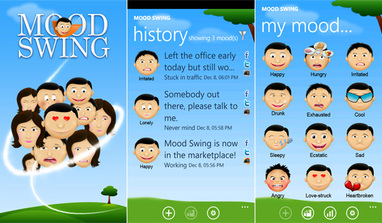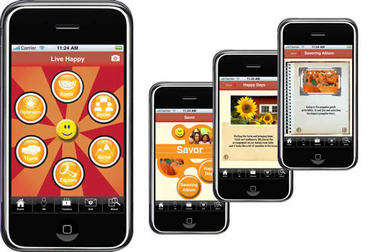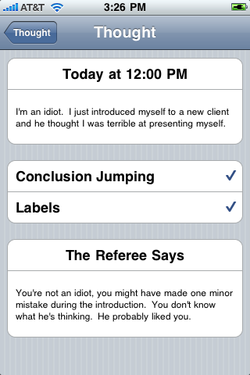|
America was founded on this principle: the pursuit of happiness. Of course, the operative word here is "pursuit." No guarantees. But technology, in the form of the smartphone, has stepped up to help us in the chase. Texting, tweeting, playing Words With Friends or Angry Birds, and maybe, just maybe, making the occasional old-fashioned person-to-person call: it’s all in a day’s work for the typical Smartphone. But did you know that they soon may replace your therapist as well? Hey, we all want to be stress-free (or at least stress-reduced) happy campers who are in tune with our feelings at any moment of the day or night, right?!?  Well, lo-and-behold, there is an app to help you with that. Numerous apps. (And by the time you read this, probably a few more.) And best of all, they are all either free or a lot cheaper than a session on a psychiatrist’s couch. So grab your phone and download nirvana (or an approximation of it).  2012 equivalent of a mood ring: Mood Finger Scan Moody Blues Not sure what mood you are in right now? Remember those Mood Rings from the mid- 70's (the first Me Decade)? You’d wear one and the stone would turn a certain color depending on how your were feeling: black for stressed and nervous, blue for calm and collected, green for “normal” (whatever that means). Well, now there are Mood Apps like Mood Scanner (Android) and Mood Finger Scan (iPhone). Just scan an available body part (I’m talking fingers or thumbs here) and the app will report your present emotional conditions. Judging by the customer reviews, these apps work as well as the original Mood Rings! (But hey, at least they’re free!)  Mood Swing app If you are really into over-analyzing every breath you take (and every emotional move you make), perhaps a “mood-minder” app is just the thing for you. These apps require that you check in at least once a day (or once an hour, or every fifteen minutes depending on how neurotic you are) to record your mood and whatever is happening in your life at that moment that might be influencing that mood. The app will analyze your data and present you with an infographic of charts and calendars that give you an overview of your every emotional high and low: who’s bringing you down, what picks you back up, and any place that might be your personal valley of the shadow. These apps include Mood Swing, which lets you track your mood with “beautiful expressions and mood images” (cartoon faces smiling, frowning, staring wistfully) and share your current mood on both Facebook and Twitter. (Of course! Because if you don’t share your mood swing with 180 of your friends, it didn’t really happen.)  Mood panda app MoodPanda has similar features, but longer hair ---oops, no --- a cute Panda to accompany the infographics. Then there’s Moody Me which purports that “you will have more happy days” if you use it. This app allows you to create a slideshow of pictures of people, places or things that make you happy. Then you can play it whenever you need “an instant lift.”  Live Happy screenshots A Psychologist at your Fingertips Who has time to visit a therapist these days? And who really wants to talk to another human being about her... issues? Especially when you can consult a therapist in the palm of your hand. Therapy apps purport to teach you cognitive and behavioral strategies to cope with your problems. Live Happy bills itself as a “happiness boosting positive psychology program,” based on research by Dr. Sonja Lyubomirsky, professor of psychology at the University of California and author of The How of Happiness. Among the “get happy” activities that it offers are a prompt for remembering happy days, a reminder to savor the moment (take a photo of your special person, place or thing and enter a brief note as to why you value it), and a kindness journal.  MoodKit app Mood Kit also provides activities to improve your mood in a variety of life categories: productivity, physical fitness, health habits, your participation in the social scene, etc. It also includes a “thought checker” to help you weed out all that negativity that might creep in at 3 am during one of those long, dark nights of the soul, when you've been left dateless with just a quart of Oberweis Udderly Truffles ice cream to console you.  A couple of apps feature the use of Cognitive Behavioral Therapy, which works on the theory that we think thoughts all the time and some thoughts can have a big impact on our mood. (Duh!!!) By writing down our thoughts and studying them, we can train our brains to react differently in the future. By identifying forms of "bad thinking" are these thoughts, you become an expert at how your brain is affecting your mood. Often it's not your actual life situation that's causing the depression, it's those constant negative thoughts about the situation. (The psych term is “perseveration,” like when someone’s always picking away at a scab.)  iCouch CBT (Cognitive Behavioral Therapy) -- love the allusion!!-- offers a step-by-step process by which you can change those negative, distorted thoughts (“I am the worst person in the whole world”) into more positive, not-so-distorted ones (“I may have my faults, but  I am definitely a few steps above Charles Manson and ...”) If you are willing to part with some cash, you can upload your files to iCouch and a licensed psychologist will analyze how you are using the app and give you suggestions for improvement.  CBTReferee app CBTReferee runs on your iPhone, iPad, iPod Touch or Android device! You write down the thoughts in your head when they happen in order to catch flawed thinking and learn from it. You invent your own “referee” who gives you the fair take on each thought vs. a negative or biased view. When a completely unfair thought comes into your head, like "I'm an idiot," you don't just accept it as true. Whip out your phone, thumb it into the app and the referee will blow his whistle. Time out and the cheating team does not score the goal and bring you down!  Then there’s this app, which seems pretty far out there, way beyond left field. Brain Freqz purportedly works on the premise that mental states can be associated with brainwave frequency. For example, a person in a relaxed state may exhibit brain waves in the frequency range of 8 to 13 hertz. Brain waves in the frequency range of 1 to 3 hertz would indicate a state of deep, dreamless sleep. Certain frequencies are associated with healing and/or enhancing specific functions. The process of bringing your brain waves to specific frequency ranges is called “entraining.” BrainFreqz audio programs use various audio technologies including "isochronic tones," "monaural beats" and "binaural beats" to "entrain" brain waves. (I am not making this crap up!) The app maker claims that this practice is very useful for relaxing, becoming more focused, inducing sleep, etc... Current BrainFreqz offerings include Relaxation, Stimulation, Sleep, Headache Relief and Euphoria. (Wow, all for the low, low price of 99 cents! Talk about a cheap high! I want to get me a fix!) So, are we having fun yet? All this self-absorption! No wonder the world is going to hell in a flippin' handbasket!
0 Comments
Leave a Reply. |
AuthorTo find out more about me, click on the Not Your Average Jo tab. Archives
February 2024
Categories
All
|
 RSS Feed
RSS Feed